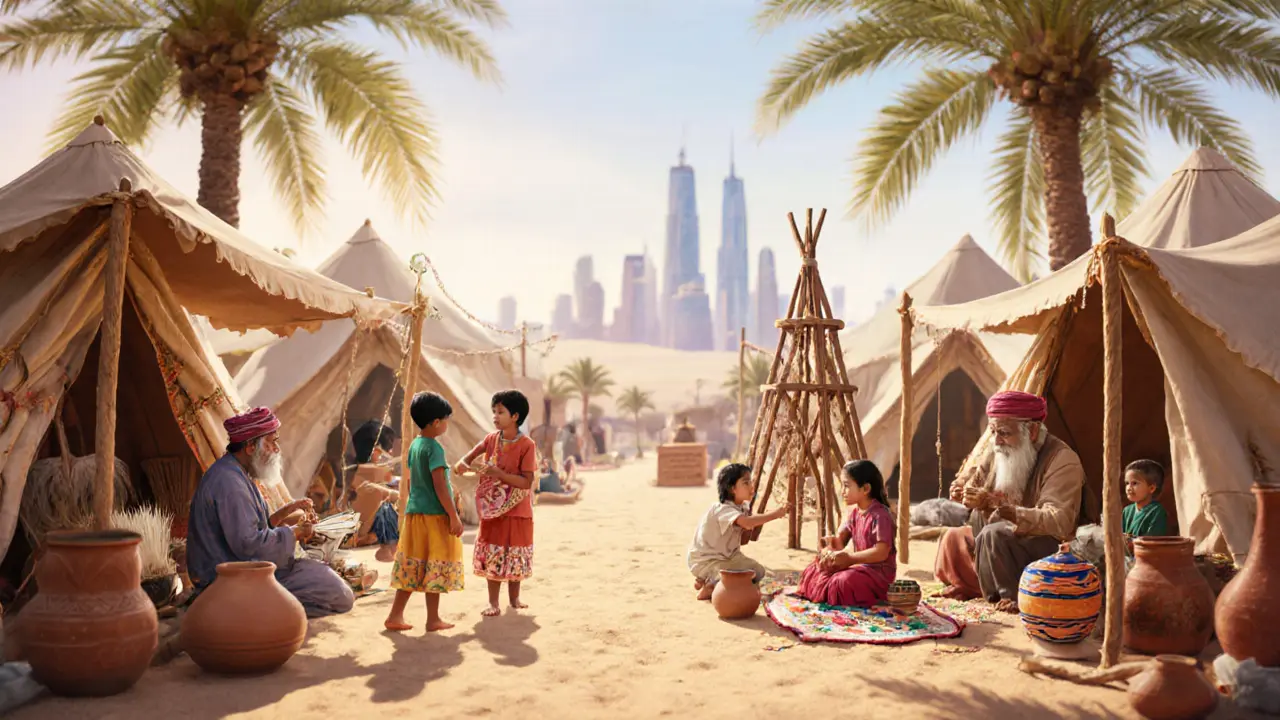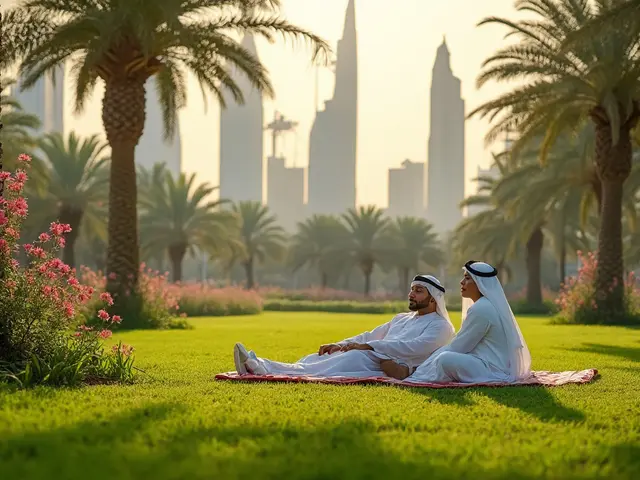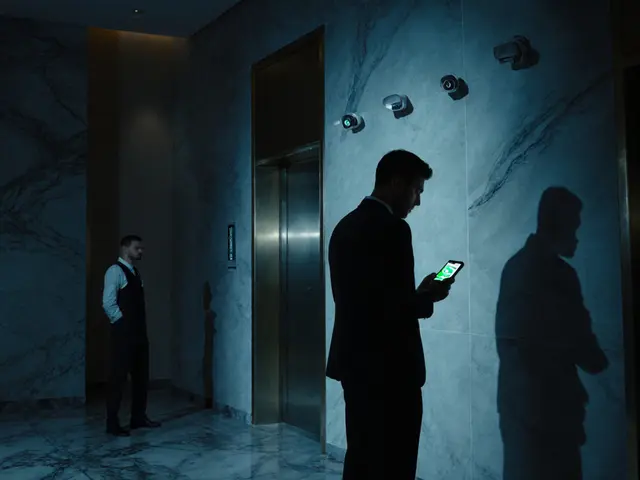
When people think of Dubai, they picture skyscrapers, luxury malls, and desert safaris. But beneath the glitter and glass lies a city that still holds tightly to its roots. If you want to understand Dubai-not just see it-you need to step away from the neon and into the quiet alleys, bustling souks, and centuries-old wind towers. These aren’t just tourist stops. They’re living pieces of a culture that survived oil booms, globalization, and rapid change.
Al Fahidi Historical Neighborhood
Start with Al Fahidi, also known as Al Bastakiya. This is the oldest surviving residential area in Dubai, dating back to the late 1800s. The narrow winding streets are lined with coral stone and gypsum buildings, each with wind towers that naturally cooled homes before electricity. You won’t find fast food chains here. Instead, you’ll find restored homes turned into small museums, art galleries, and cafés serving cardamom coffee.
At the Dubai Museum, housed in the 1787 Al Fahidi Fort, you’ll see how locals lived before the oil boom-using dhows for fishing, trading pearls, and farming dates in the desert. The museum’s dioramas show life as it was: women weaving mats from palm fronds, men repairing nets, children playing with clay toys. It’s not flashy, but it’s real.
Dubai Creek and the Abra Ride
Before the Burj Khalifa, before the Mall of the Emirates, Dubai grew along Dubai Creek. This saltwater inlet was the city’s lifeline for trade. Today, you can still cross it the way locals have for generations-on an abra, a small wooden boat powered by a single engine.
For just 1 dirham (about 27 cents), you ride across the creek from Bur Dubai to Deira. The ride takes five minutes. But in that time, you’ll see fishermen hauling in their catch, cargo ships unloading spices, and women in abayas chatting with vendors on the shore. The smell of dried fish and cardamom mixes with the salty breeze. It’s chaotic, alive, and utterly authentic.
Gold Souk and Spice Souk
Walk into the Gold Souk and you’ll feel like you’ve stepped into a scene from a fairy tale. Stalls overflow with gold necklaces, bracelets, and intricate bangles. The air hums with haggling voices and the clink of metal. But this isn’t just a shopping center-it’s a working marketplace where families have traded for generations. Many shop owners still use the old system: weighing gold on brass scales, testing purity with acid, and wrapping purchases in tissue paper by hand.
Just steps away is the Spice Souk. Here, piles of saffron, cumin, turmeric, and dried limes spill from wooden crates. The scent is overwhelming-sweet, sharp, earthy. You’ll see women buying whole spices for their daily biryani, and tourists sniffing oud incense. Vendors will offer free samples of cardamom tea or rosewater. Don’t be shy. It’s part of the tradition.

Jumeirah Mosque and Cultural Understanding
One of the few mosques in Dubai open to non-Muslim visitors, Jumeirah Mosque offers guided cultural tours. These aren’t just architectural walkthroughs. They’re conversations. You’ll learn why the mosque has two minarets (symbolizing balance), how the white limestone reflects sunlight to keep interiors cool, and why prayer rugs face Mecca.
Guides often share stories about daily life-how families gather for iftar during Ramadan, how children learn Quranic verses at home, why modest dress matters even in a global city. The mosque doesn’t just show you Islam-it shows you how it lives in Dubai today.
Heritage Village
At Heritage Village, you won’t find ticket booths or selfie sticks. Instead, you’ll find artisans doing what they’ve always done: weaving wool into tents, shaping clay pots, making dates into sweets. Women sit under shaded awnings, stitching traditional embroidery with thread dyed using natural pigments. Men demonstrate how to build a barjeel (wind tower) or carve wooden doors.
It’s not a museum with glass cases. It’s a working space. You can try your hand at weaving a basket or pressing date syrup. Kids run barefoot on sand paths while elders teach them songs in Arabic. This is cultural preservation-not performance.

Dubai Coffee Museum
Coffee isn’t just a drink in Dubai-it’s a ritual. The Dubai Coffee Museum, tucked into a restored house near Al Fahidi, tells the story of how coffee moved from Ethiopia to the Arabian Peninsula and became central to Emirati hospitality. You’ll see antique copper pots (dallahs), hand-carved coffee grinders, and cups made from camel bone.
At the end of the tour, you’re offered a cup of qishr, a spiced coffee made with ginger, cardamom, and sugar. The host will explain how offering coffee to guests is a sign of respect. Refusing it? That’s rude. Sipping slowly? That’s polite. This isn’t just about taste. It’s about manners.
Traditional Dhow Cruises
Most tourists take dinner cruises on modern yachts. But if you want to feel the pulse of old Dubai, book a traditional dhow cruise. These wooden boats, built using centuries-old techniques, sail along Dubai Creek or the Marina after sunset. No loud music. No DJs. Just the sound of waves, the murmur of conversation, and the glow of lanterns.
Onboard, you’ll eat grilled fish, hummus, and tabbouleh served on low tables. The crew might sing a traditional sea shanty. You’ll learn how fishermen used stars to navigate before GPS. It’s quiet. It’s slow. And it’s the closest thing to time travel you’ll find in Dubai.
Why These Places Matter
Dubai didn’t erase its past to build its future. It folded both into one. These attractions aren’t relics. They’re active parts of daily life. A grandmother still buys spices at the Souk. A teenager learns to weave at Heritage Village. A businessman starts his day with cardamom coffee before heading to his office in a skyscraper.
Visiting these places isn’t about checking boxes. It’s about understanding how a culture holds onto identity while changing at lightning speed. You don’t need to buy a souvenir. You just need to sit quietly, watch, listen, and accept the offer of a cup of coffee.
Are these traditional attractions crowded with tourists?
Some, like the Gold Souk and Jumeirah Mosque, get busy during peak hours. But most places-like Al Fahidi, Heritage Village, and the Coffee Museum-are quiet in the mornings and on weekdays. Go early, and you’ll have space to breathe. Locals visit these spots daily, so they’re not just for tourists.
Do I need to dress a certain way to visit these places?
Yes, modesty is expected. Shoulders and knees should be covered, especially at mosques and heritage sites. Loose clothing, long sleeves, and pants or skirts are best. You don’t need to wear a headscarf unless entering a mosque, but many women choose to out of respect. Comfortable shoes matter too-many places have uneven stone paths.
Can I take photos everywhere?
You can photograph buildings, markets, and landscapes. But never take pictures of people without asking-especially women and children. Some vendors might say no to photos of their goods. Always respect a simple "no." In places like Heritage Village, photographers are welcome, but loud groups or drone use are discouraged.
Is it worth visiting these places if I only have one day in Dubai?
If you only have one day, focus on Al Fahidi, the Spice Souk, and a dhow cruise. You can walk between Al Fahidi and the Creek in 15 minutes. Take an abra across, spend an hour in the Souk, then book a sunset dhow ride. That’s enough to feel the soul of old Dubai without rushing.
Are these attractions free to enter?
Most are low-cost or free. Al Fahidi neighborhood is open to the public. The Dubai Museum costs 3 dirhams for adults. The Coffee Museum charges 10 dirhams. Jumeirah Mosque tours are free, but you need to book in advance. The abra ride is 1 dirham. These aren’t expensive experiences-they’re affordable windows into a living culture.
What’s the best time of year to visit these traditional sites?
November to March is ideal. Temperatures are mild, between 20°C and 28°C. Summer is too hot-45°C in the shade makes walking around uncomfortable. Winter also brings cultural events like the Dubai Heritage Festival, where artisans, storytellers, and musicians gather in Al Fahidi. Go then, and you’ll see the culture in full motion.




